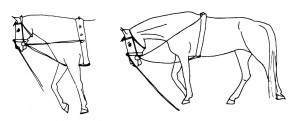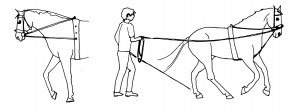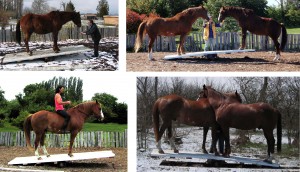Work on the Lunge Line – Part 13
|
|
Arbeit an der Longe – Teil 13
|
Overview over auxiliary reins:
- Running side-reins are passed under the surcingle under the belly of the horse and split on the chest into two reins, which, passed through the side rings of the cavesson (or later the bit of the bridle), then are hooked into the top ring of the surcingle. They induce the horse to let the head and neck fall. They leave him more freedom of movement than straight side-reins (whether from the side or from under the chest). But they don’t give stability to the sides and can lead to the horse coming too low and falling onto the forehand. (right)
|
|
Überblick Hilfszügel:
- Der Dreieckszügel wird am Gurt unter dem Bauch des Pferdes angebracht und teilt sich auf der Brust in zwei Zügel, die, durch die seitlichen Ringe des Kappzaums (oder später die Trensenringe) geführt, dann in den obersten Ring im Gurt verschnallt werden. Er soll das Pferd dazu bringen, Kopf und Hals fallen zu lassen. Er läßt dem Pferd damit etwas mehr Bewegungsraum als Ausbinder oder Stoßzügel. Er gibt aber keine seitliche Stabilität und kann außerdem dazu führen, daß das Pferd zu tief kommt und auf der Vorhand läuft. (rechts)
|
 Left: according to Ph. Karl the horse would go against the reins here. Right: the horse finds the way down.
|
- When fixed under the belly and then to the side at the point of the shoulder, they are supposed to help the horse to round his back and let the neck drop. This however is the way which, according to Ph. Karl, should not be used, as the horse will tend to go against the rein. (left)
- Draw reins in two parts have loops at either ends and run from the surcingle at the point of the shoulder through the rings of the cavesson or bridle and then to the top of the surcingle behind the withers. They encourage the horse to carry his head higher and also give the horse guidance sideways. (left)
|
|
- Als Dreieckszügel auf Bughöhe verschnallt sollen sie dem Pferd helfen den Rücken aufzuwölben und den Hals fallen zu lassen. Dies ist jedoch die Verschnallung, die nach Ph. Karl nicht angewendet werden sollte, da das Pferd dann gegen den Zügel geht. (links)
- Der Laufferzügel ist ein geteilter Dreieckszügel. Er hat an beiden Enden eine Schlaufe und wird seitlich in der Höhe des Buggelenks verschnallt, dann durch die Trensenringe geführt und oben hinter dem Widerrist wieder am Gurt befestigt. Sie sollen das Pferd zu einer höheren Kopfhaltung anregen und geben auch seitliche Stabilität. (links)
|
 Elevation is needed for collection.
Für Versammlung ist Aufrichtung nötig. |
- They can of course also be affixed like running reins and then serve to make the horse drop his neck just like them.
- The larger the triangle of the reins the more elevation the horse will show – this therefore is used for work on collection. (right) In all cases the reins have to be long enough so the horse can carry his head slightly in front of the vertical. Like this the horse retains the will to go forward: it is not disturbed in the mouth and shows no averse reaction to the auxiliary reins.
- For the vaulting horse as well you should use auxiliary reins during training, which allow the horse freedom of movement in the horizontal direction. With straight side-reins in a competition make sure that the horse has his nose in front of the vertical. Stand in front of the horse and lift his head with both hands in the rings of the bit: if the head reaches the vertical and a bit beyond without problem this is correct. At the side they should be at the height of the shoulder and run horizontally.
- It is a myth that it “helps” the horse to bend by pulling his head to the inside via side-reins. In a coerced position the horse will never learn to balance himself. Instead of buying expensive equipment you can use a thin rope (such as a clothes line) and achieve exactly the same results. (left, click picture for enlargement)
|
|
- Unter dem Bauch verschnallt wie der vorher erwähnte Dreieckszügel führt er ebenfalls dazu, daß das Pferd den Kopf fallen läßt.
- Je größer das Dreieck der Zügel, desto höher die Aufrichtung des Pferdes – diese Verschnallung wird also für versammelnde Arbeit verwendet. (rechts) In allen Fällen müssen die Zügel lang genug sein, so daß das Pferd den Kopf leicht vor die Senkrechte bringen kann. So bleibt beim Pferd der Wille vorwärts zu gehen erhalten, es stört sich nicht im Maul und zeigt daher keine Gegenwehr gegen den Hilfszügel.
- Auch beim Voltigepferd sollten im Training nur Hilfszügel verwendet werden, die vollkommen freie Beweglichkeit in waagrechter Richtung erlauben. Beim Verschnallen der leidigen Ausbinder für einen Voltigewettkampf muß darauf geachtet werden, daß der Kopf des Pferdes nicht hinter die Senkrechte gezogen wird. Man stellt sich dafür vor das Pferd und hebt seinen Kopf mit beiden Händen in den Trensenringen an: Korrekt wäre, wenn der Kopf problemlos die Senkrechte und ein bißchen darüber erreicht. Seitlich sollen sie in Höhe des Buggelenks etwa waagrecht verlaufen.
- Daß es dem Pferd “hilft” sich zu biegen, wenn man ihm den Kopf nach innen zieht ist natürlich ein Mythos. Das Pferd lernt in keiner Zwangsposition sich selbst auszubalancieren. Mit einem Stück Wäscheleine kann man, wenn man teure Ausrüstung vermeiden will, genau dieselben Resultate erreichen. (links, klicken Sie aufs Bild zum Vergrößern)
|
|
|
- Gogue (with influence onto the poll and the jaws) and chambon (with influence onto the poll only) belong to the “hard” reins, which can lead to fierce resistance from the part of the horse. They are used for spoiled horses, which need to be corrected, if they constantly rip their heads up and refuse their backs. For an unspoiled correctly worked horse they are unnecessary. Both of them do not belong into the hands of a beginner!
- If you study the literature on the subject of auxiliary reins you will find a real mountain of additional equipment that you can buy. There are fantastically complicated ways of wrapping your horse up in fancy looking lines – please DO remember: the equipment does not make the good lunger – and you don’t need any of them! If you get a solid handle on your sensitive touch with simple running reins and lunge line, you are set up for success. All else you need is a good eye to see where the problems lie, and the knowledge to fix, not the symptoms, but the cause of them (for both read again the H.E.M. articles!).
- The test, whether the auxiliary reins truly help the horse, is the achievement of clean gaits. A horse only goes with good rhythm is he is balanced. With the addition of two to three vaulters on his back, this balance can become particularly challenging. Balance is the mastery of your own gravity point!
- Here too we recommend complementary games for useful and enjoyable variety – and teach him the concept of his gravity point at the same time! See how much fun horses can have on a see-saw –book page 148 and films! http://youtu.be/hpMu__Y5EFc
|
|
- Gogue (mit Wirkung auf Genick und Laden) und Chambon (mit Wirkung auf das Genick) gehören zu den “harten” Zügeln, die zu heftiger Gegenwehr des Pferdes führen können. Sie werden nur bei Korrekturpferden eingesetzt, die den Kopf hochreißen und den Rücken wegdrücken. Bei korrekt gearbeiteten Pferden sind sie unnötig. Beide gehören nicht in die Hand von Laien!
- Wenn Sie die Literatur über Hilfszügel lesen, werden Sie feststellen, daß es da noch einen ganzen Berg von Ausrüstung gibt, den Sie kaufen können. Es gibt wahrlich fantastische Sachen, um Ihr Pferd in schick aussehenden Leinen zu verpacken – bitte erinnern Sie sich, daß die Ausrüstung nicht den guten Longentrainer macht! Sie brauchen von alledem nichts. Wenn Sie Ihre Hilfen mit sensiblem Touch mit einfachen Laufferzügeln und der Longe geübt haben, sind Sie auf dem besten Weg zum Erfolg. Alles was Sie zusätzlich brauchen ist ein gutes Auge, um zu erkennen wo die Probleme herkommen, und das Wissen, nicht die Symptome, sondern die Ursachen zu korrigieren. (Für beides lesen Sie noch einmal die H.E.M. Artikel!)
- Die Probe aufs Exempel, ob die Hilfszügel wirklich helfen ist die Reinheit der Gänge. Ein Pferd geht nur im Takt, wenn es ausbalanciert ist. Wenn dazu noch bis zu drei Voltigierer auf ihm herumturnen, ist die Balance besonders schwierig.
- Auch hier empfehlen wir ergänzende Spiele für das Pferd, die ihm, neben einer vergnüglichen Abwechslung, auch noch ein gutes Gefühl für seinen Schwerpunkt vermitteln. Pferde haben viel Spass auf der Wippe — Buch LtL Seite 148 und Filme “Playing with Horses” http://youtu.be/hpMu__Y5EFc
|
 On the see-saw the horse explores his gravity point.
Auf der Wippe erfährt das Pferd seinen Schwerpunkt. |
- If the horse only goes forward-downward he will come onto the forehand. During schooling extension posture does not mean eating-posture! During training it is important that the impulsion of the horse is retained or promoted, and for this a relative elevation is necessary.
- Therefore an adjustment of the auxiliary reins in length as well a height is always needed between the phase of warm-up (relaxation phase), the work itself (elevation) and the cool-down phase (extension).
- Let me remind you that, as long as the horse tends to run and buck, we will fix neither running reins nor lunge line to the bit. Later the auxiliary reins are fixed to the bit, but the lunge remains attached to the cavesson.
Warm-up phase:
During warm-up we start without running reins until the horse has found natural rhythm in walk and trot. A helper leads the inexperienced or nervous horse out onto the circle line and stays with him until he calms down. Then we connect the auxiliary reins in position for relaxation – inducing the horse to drop his head, and start seeking some contact to us on the lunge line. We work on both hands. The length of the warm-up should be at least ten minutes, but with a nervous horse as long as it takes. There is no sense in making any kind of “schooling” demands as long as the horse is nervously cramped up!
Schooling phase:
- For the schooling phase the running reins are attached with a larger triangle for elevation. As soon as the horse is calm and trusting, the lunge line can also be attached to the bit, though some famous trainers reject this outright. Here too we must adjust the length of the reins often – you watch your horse and always make sure that he can remain relaxed during your schooling demands. If the horse keeps his mouth rigid and does not seek a “conversation” with you by chewing – back to the cavesson!
- We will discuss later how you could structure your schooling phase to make it interesting for the horse.
Cool-down:
- For the cool-down phase the auxiliary reins can be removed, but the conversation isn’t over yet. The horse should still seek the contact on the lunge line and perform some easy exercises. Choose something for this which the horse likes to do! Remember that he will always take home the last impression from a schooling session in his memory, and will base his motivation for being glorious for you the next time on this! Then you end the session by going for a little walk.
Next time we’ll recapitulate and begin to exercise what we have learned so far. |
|
- Wenn das Pferd nur vorwärts-abwärts läuft, kommt es auf die Vorhand. Dehnungshaltung bedeutet nicht Freßhaltung! Wichtig ist in der Ausbildung, daß beim Pferd der Schwung erhalten bzw. gefördert wird, wozu eine relative Aufrichtung nötig ist.
- Daher ist eine Veränderung der Verschnallung in Länge und Höhe also zwischen dem Aufwärmen (Lösungsphase), der Arbeitsphase (Aufrichtung) und der Auslaufsphase hinterher (Dehnen) notwendig.
- Bitte erinnern Sie sich, daß wir, solange das Pferd noch rennt oder buckelt, weder die Hilfszügel noch die Longe in der Trense verschnallen. Später werden die Hilfszügel meist in den Trensenringen eingehängt und die Longe bleibt am Kappzaum..
Lösungsphase:
- Wir beginnen die Aufwärmphase ohne Hilfszügel bis das Pferd seinen natürlichen Rhythmus im Schritt und Trab gefunden hat. ein Helfer führt das nervöse oder unerfahrene Pferd auf die Zirkellinie und bleibt neben ihm, bis es sich beruhigt hat. Dann verschnallen wir die Hilfszügel für die Entspannungshaltung – wobei nun das Pferd seinen Kopf und Hals fallen lassen und gleichzeitig einen Kontakt zu der Longenhand suchen sollte. Wir arbeiten auf beiden Seiten. Die Länge der Aufwärmphase sollte mindestens 10 Minuten betragen, aber mit einem nervösen Pferd eben solange, bis es sich löst. Es hat keinerlei Sinn eine “Schulung” zu beginnen, solange das Pferd noch nervös verkrampft ist!
Arbeitsphase:
- Für die Arbeitsphase werden die Hilfszügel dann mit einem größeren Dreieck für mehr Aufrichtung verschnallt. Sobald das Pferd ruhig und vertrauensvoll arbeitet kann die Longe dann im Trensenring befestigt werden, obwohl manche berühmte Trainer das kategorisch ablehnen. Auch hier müssen wir die Länge der Hilfszügel oft anpassen – beobachten Sie Ihr Pferd genau und versichern sich immer wieder, daß es bei Ihren Ansprüchen der Ausbildung entspannt bleibt. Wenn das Pferd sein Maul fest und verspannt hält und keine “Unterhaltung” mit Ihnen sucht, greifen Sie wieder zum Kappzaum!
- Später erwähnen wir, wie man die Schulungsphase so strukturiert, daß sie dem Pferd interessant ist.
Entspannungsphase:
- In der Entspannungsphase können die Hilfszügel abgemacht werden, aber die Unterhaltung ist noch nicht vorbei. Das Pferd sollte noch aufmerksam bleiben und von Ihnen verlangte leichte Übungen ausführen. Suchen Sie hierfür etwas aus, was das Pferd gerne tut! Erinnern Sie sich, daß das Pferd immer den letzten Eindruck einer Unterrichtsstunde im Gedächtnis mit nach Hause nimmt – und sich die Lust, das nächste Mal für Sie glorios zu sein, darauf basiert! Dann beenden Sie den Tag mit einem kleinen Spaziergang im Grünen, wo immer möglich.
Das nächste Mal rekapitulieren wir und üben, was wir bis hierher gelernt haben. |
|
|
|
|





